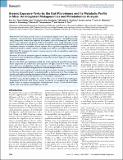Arsenic Exposure Perturbs the Gut Microbiome and Its Metabolic Profile in Mice: An Integrated Metagenomics and Metabolomics Analysis
Author(s)
Lu, Kun; Schlieper, Katherine Ann; Graffam, Michelle E.; Wishnok, John S.; Swenberg, James A.; Levine, Stuart S.; Abo, Ryan; Fox, James G; Tannenbaum, Steven R; ... Show more Show less
DownloadFox_Arsenic exposure.pdf (910.2Kb)
PUBLISHER_POLICY
Publisher Policy
Article is made available in accordance with the publisher's policy and may be subject to US copyright law. Please refer to the publisher's site for terms of use.
Terms of use
Metadata
Show full item recordAbstract
Background: The human intestine is host to an enormously complex, diverse, and vast microbial community—the gut microbiota. The gut microbiome plays a profound role in metabolic processing, energy production, immune and cognitive development, epithelial homeostasis, and so forth. However, the composition and diversity of the gut microbiome can be readily affected by external factors, which raises the possibility that exposure to toxic environmental chemicals leads to gut microbiome alteration, or dysbiosis. Arsenic exposure affects large human populations worldwide and has been linked to a number of diseases, including cancer, diabetes, and cardiovascular disorders.
Objectives: We investigated the impact of arsenic exposure on the gut microbiome composition and its metabolic profiles.
Methods: We used an integrated approach combining 16S rRNA gene sequencing and mass spectrometry–based metabolomics profiling to examine the functional impact of arsenic exposure on the gut microbiome.
Results: 16S rRNA gene sequencing revealed that arsenic significantly perturbed the gut microbiome composition in C57BL/6 mice after exposure to 10 ppm arsenic for 4 weeks in drinking water. Moreover, metabolomics profiling revealed a concurrent effect, with a number of gut microflora–related metabolites being perturbed in multiple biological matrices.
Conclusions: Arsenic exposure not only alters the gut microbiome community at the abundance level but also substantially disturbs its metabolic profiles at the function level. These findings may provide novel insights regarding perturbations of the gut microbiome and its functions as a potential new mechanism by which arsenic exposure leads to or exacerbates human diseases.
Date issued
2014-01Department
Massachusetts Institute of Technology. Department of Biological Engineering; Massachusetts Institute of Technology. Department of Biology; Massachusetts Institute of Technology. Department of Chemistry; Massachusetts Institute of Technology. Division of Comparative MedicineJournal
Environmental Health Perspectives
Publisher
Environmental Health Perspectives
Citation
Lu, Kun, Ryan Phillip Abo, Katherine Ann Schlieper, Michelle E. Graffam, Stuart Levine, John S. Wishnok, James A. Swenberg, Steven R. Tannenbaum, and James G. Fox. “Arsenic Exposure Perturbs the Gut Microbiome and Its Metabolic Profile in Mice: An Integrated Metagenomics and Metabolomics Analysis.” Environmental Health Perspectives (January 10, 2014).
Version: Final published version
ISSN
0091-6765
1552-9924